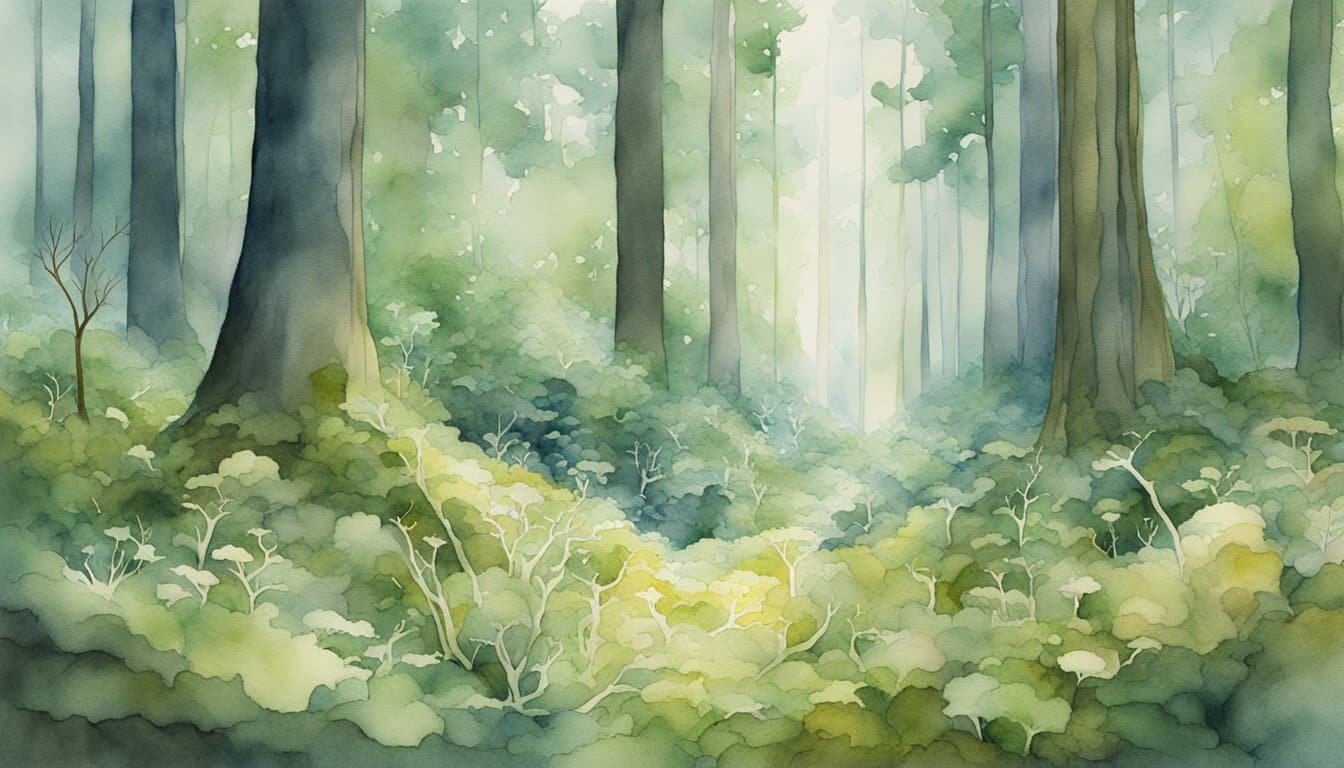Understanding Mycelium
Mycelium is the intricate, thread-like structure that serves as the vegetative growth stage of fungi. It’s a vast, subterranean network integral to life on earth, forging connections both littoral and literal beneath our feet.
Mycelium and Fungal Biology
Fungi encompass a diverse kingdom of organisms crucial for many ecosystems’ health and function. The mycelium is essentially the fungal “roots,” but instead of roots, these are networks of hyphae. These hyphae grow from spores, which germinate under suitable environmental conditions, branching out through soil or other substrates like a microscopic web. They are responsible for the growth and development of the fungus, allowing it to thrive by absorbing nutrients and organic matter.
Mycelium in Natural Ecosystems
In natural ecosystems, mycelium works tirelessly, decomposing organic materials and cycling vital nutrients through the soil. This process makes nutrients available to plants, which in turn support a variety of life forms above ground. Mycorrhizal fungi form symbiotic relationships with plant roots, exchanging water and nutrients for carbohydrates, a process that is essential for the health of most plant species.
Mycelium as a Resource
Mycelium isn’t just an ecological marvel; it’s also a resource for sustainable materials. Through the ingenuity of scientists and designers, mycelium has been harnessed to create bio-composites used in everything from packaging to building materials. These applications capitalize on mycelium’s natural properties, such as insulation and structural strength, while simultaneously tapping into its eco-friendly potential through compost and agricultural waste that otherwise may contribute to environmental degradation.
Mycelium-Based Applications

Mycelium, the root structure of fungi, offers a myriad of practical applications by transforming various industries with eco-friendly solutions ranging from materials for fashion to sustainable construction additives.
Mycelium in Environmental Solutions
Fungi have a natural talent for breaking down organic matter, which is strategically harnessed in bioremediation to clean up contaminated environments. Mycoremediation, a subset of bioremediation, specifically utilizes mycelium to address waste and plastics issues by breaking them down. The result is a significant reduction in municipal solid waste and plastic packaging, potentially mitigating greenhouse gas emissions linked to waste decomposition in landfills. For instance, some companies are experimenting with mycelium to create sustainable packaging solutions that decompose naturally, contrasting sharply with traditional plastics.
Mycelium-based bio-composite materials for design and architecture are under development, aiming to propel industries towards greener practices. As a sustainability champion, mycelium can be grown into custom shapes, reducing embodied energy in materials and offering a compostable end-of-life option.
Mycelium in Industry and Commerce
In industries like fashion, mycelium serves as a substitute for leather, creating cruelty-free, biodegradable materials that mimic traditional leather’s durability and texture. Companies have produced mycelium-based leather that integrates seamlessly into existing manufacturing processes used for goods like shoes and bags. Turning to the construction industry, mycelium has been explored as an additive to make building materials such as bricks stronger and more insulative while also replacing conventional cement mixes, leading to lower carbon footprints.
Numerous researchers are exploring the potential for these applications. The ongoing innovations with mycelium showcase a promising future where high-performance materials align with environmental stewardship.
Innovations and Research in Mycelium

Mycelium, the root structure of fungi, is transforming industries with its exceptional versatility. Researchers and innovators are leveraging its innate traits to develop cutting-edge biomaterials which are both sustainable and possess remarkable mechanical properties.
Cutting-Edge Mycelium Technologies
Scientific curiosity has turned ordinary mycelium into a hub of extraordinary biomaterial developments. Tapping into the unique protein composition and enzymes within mycelium, experts are engineering green composites suited for modern applications. The spotlight is on mycelium-based materials as leather substitutes for their durability and eco-friendly attributes, which are studied through various scientific explorations.
These innovations extend to the realm of architecture and design, where mycelium’s robustness is enhanced through compression tests, resulting in strong, lightweight construction elements. Moreover, mycelium’s ability to bind with polymers and other organic materials yields products like biodegradable furniture, hinting at a future of fully sustainable interior materials. One such exploration demonstrates mycelium’s potential in creating green composites utilizing agro-industrial wastes, reinforcing the notion of sustainable innovation.
Future Prospects
Gradually, mycelium is paving the way towards a new era of natural materials. Further research into the structural matrix of mycelium reveals the presence of beta-glucans, components that contribute to both the health sector and the structural integrity of developed materials. Researchers are not only focusing on current applications but are also projecting mycelium as a viable player in the future of sustainable materials.
The road ahead involves extensive research to surmount current challenges and enhance the mechanical properties of mycelium-based materials. As strides are made, the dialogue extends into the ethics and practicality of producing mycelium at scale without compromising its environmental benefits. Details on the material’s fabrication methods and its physio-mechanical performance are vital pieces of this ongoing research discussion. By fortifying our scientific understanding, the aim is to not only respect but to also optimize the incredible capabilities mycelium has to offer.

